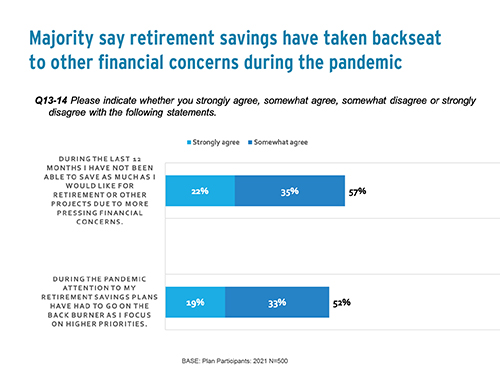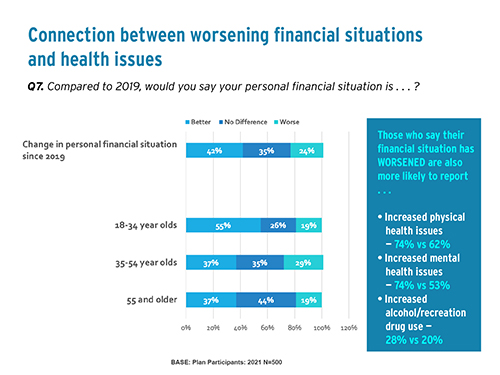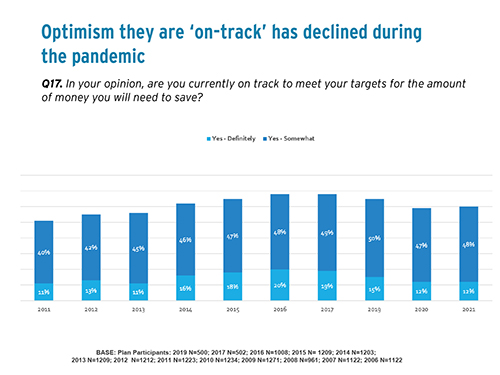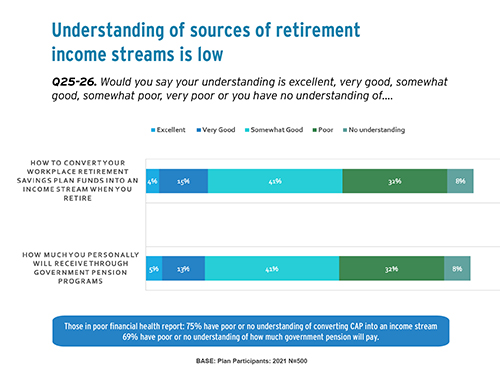
For the past 15 years, Benefits Canada’s CAP Member Survey has taken the pulse of capital accumulation plan members’ retirement readiness, their knowledge, confidence and satisfaction in their employer-provided CAPs and how their financial wellness is affecting their physical and mental health.
Tracking sentiments through the 2008/09 financial crisis, its subsequent recession and recovery and now the coronavirus pandemic, results over the past decade and a half have truly reflected the economic backdrop at the time.
Read: Webinar: 2020 CAP Member Survey: Retirement savings, financial well-being in the era of coronavirus
This year, the survey went out to the field when Canadians had a whole year of the pandemic behind them. Still, with many restrictions in place, the path ahead continues to be uncertain.
Retirement readiness and the pandemic
Looking at retirement readiness since the onset of the pandemic, fewer than half — 47 per cent in 2021 and 48 per cent in 2020 — of plan members said they feel financially prepared for retirement. This compares to 55 per cent in 2019 and 56 per cent in 2015.
In addition, while 59 per cent of CAP members said they expect no impact on their retirement age, 17 per cent expect to work longer than they anticipated due to the pandemic. As well, half said their retirement savings plans have had to take a backseat during the coronavirus crisis as they focus on other financial priorities.
During Benefits Canada’s 2021 Benefits and Pension Summit in May, Jason Vary, president of Actuarial Solutions Inc., said he sees a lot of short-termism and overreactions in these results. “To me, it’s totally understandable that many people had to put more pressing financial concerns ahead of retirement savings . . . and that’s OK, in my view, on a short-term basis.
“If you dig into the survey results . . . you’ll see that people with formal financial plans or who consult periodically with a personal financial advisor reported higher confidence in being prepared for retirement and they’re subject to less over-reaction and less short-term thinking.”
Referring to Manulife Financial Corp.’s employer clients, Erica Hall, the insurer’s vice-president and head of client relations for group retirement services, also noted a short-lived flurry of activity from both plan sponsors and members, with things levelling out at the end of 2020 and early 2021.
“Starting in April 2020, we saw a reduction in partial withdrawals, which is a great news story. It was pretty significant, down 50 per cent between April and June. . . . You can hypothesize as to what the why is, but it’s most likely to do with members needing less cash flow. . . . We found active members were still employed or they were working more and, with lockdowns and closures, they weren’t spending and that need for cash flow just wasn’t quite there.”
Read: Should early access to retirement funds be allowed due to coronavirus?
The survey results were reflected among Telus Communications Inc.’s CAP members, who didn’t pay much attention to their retirement savings in 2020, according to Carol Craig, the organization’s director of pension and benefits. She noted contributions remained fairly flat compared to the previous year, while fewer people changed their investment options.
Some 20,000 of the telecommunications company’s 27,000 employees participate in its CAP. Staff are eligible to join the plan immediately on hire and participation is voluntary for two years, at which point they’re automatically enrolled in the plan. And they can choose to contribute between three and six per cent — matched by the employer — as well as up to an additional four per cent in voluntary contributions.
In 2020, Telus worked with its partner to put out communications and a video encouraging plan members to stay the course. “We know that about 40 per cent opened and read the communication and about another 30 per cent went through to the video,” said Craig. “We think that had a bit of an impact. But really, it’s people just having other priorities and retirement savings really did take a back seat.”
Impact on overall well-being
Almost a quarter (24 per cent) of this year’s survey respondents said their personal financial situation has worsened since 2019, while 35 per cent saw no difference and 42 per cent said it was better. However, those who said it’s worsened were more likely to report increased physical health issues (74 per cent versus 62 per cent), increased mental-health issues (75 per cent versus 53 per cent) and increased alcohol and recreational drug use (28 per cent versus 20 per cent).
At Telus, mental health and well-being is an ongoing commitment that’s aligned with its social purpose, said Craig. “Now, more than ever, we have to manage mental health like any other business risk or threat to our organization.”
Read: Hyundai Canada addresses coronavirus with mental-health, connectivity initiatives
The company’s health and well-being team was able to pivot when the pandemic hit, building out its longstanding strategy by rolling out virtual health care for all employees across Canada. It also hosted virtual well-being sessions with a focus on planning for the future and launched an online education centre through its provider.
“[Employees] can register for a series of online courses about personal finance, things like budgeting [and] debt management,” said Craig, noting the company also launched an Ask an Expert series with chief executive officer Sandy Mackintosh and chief neuroscientist Dr. Diane Mackintosh.
“They’re hosting open conversations about mental health to help eliminate the stigma. These have been very well-received by the Telus team. . . . And while we’re doing all of this to make sure we’re on track of doing the right things, we’re leveraging frameworks like the national standard for psychological health and safety . . . for guidance and validation of what we’re doing.”
For several years, insurers have been connecting the dots between the importance of financial stress on mental health and productivity at work, said Hall. One example is an online wellness assessment that’s available to both benefits and retirement plan members, tying together members’ physical, mental and financial health and providing a personalized assessment and action plan.
Insurers also offer retirement income projection tools that demonstrate the cost of a balanced retirement, as well as retirement planning guidance that includes topics like budgeting, the difference between a tax-free savings account and a registered pension plan, how to talk to kids about money and what’s provided by the government.
Read: GE Canada online retirement tool helps staff learn about decumulation scenarios
“As much as we think those are basic topics that people automatically know, they actually don’t and members are asking for support in that way,” said Hall. “As well, from my perspective, the most important thing insurers are doing is really offering that financial advice, so 64 per cent of those who are considered financially well have a financial advisor. And that helps them focus on having a holistic plan that includes both their retirement and their group benefits plan. That really does help the plan member and their spouse/significant other to get the maximum out of those programs before they actually go outside to look at other sorts of products.”
Satisfaction and confidence in CAPs
With so many years under its belt, the CAP Member Survey is able to compare and contrast plan members’ feelings over the years. For example, before the 2008/09 financial crisis, during the subsequent recession and the recovery, CAP members satisfaction with their employer-sponsored plan hovered between 79 per cent and 88 per cent. In 2021, that satisfaction has dipped to 77 per cent.
As well, when members were asked how confident they are their group plan will provide them with the money they need in retirement, that figure dropped from 2016’s high of 77 per cent to 63 per cent in 2021. And optimism around being ‘on-track’ has fallen from its 2016 and 2017 high of 68 per cent to 60 per cent in 2021.
“I don’t think we should be surprised people are more pessimistic in a pandemic in general,” said Vary. “In perspective, 77 per cent are satisfied with their plan; that is a really high number, so I don’t think we need to necessarily panic, though the trend is a bit worrying. We’ll see if it bounces back quickly when this all passes.”
To educate and engage plan members, Hall highlighted personalization, persistence and consistency. “From my perspective, one of the best ways that sponsors can ensure their employees are engaged is to offer advice,” she said, noting it’s about planting the seeds. “So when a member is ready to receive that information or is in a position where they are ready to have a conversation with an advisor, they know where to go, they’ll recall that the service is available within their group program . . . and they know how to reach out to get that.”
Read: Editorial: Pandemic just the latest challenge facing retirement readiness
She also advised employers to be prepared to make plan design changes. “Sometimes, the things we think are working for a plan actually isn’t working for the members. Without surveying [employees] or knowing that, you’re not able to make decisions. So just be prepared that you might have to make some plan design changes.”
While Telus provides education sessions and communicates digitally, its main focus is designing its CAP to recognize that not all members, who are at different stages in their lives and careers, will be interested in retirement savings. “We’re trying to design it so we can . . . help them grow their retirement savings withoutthem having to be that interested,” said Craig, noting the organization studies retirement readiness on a regular basis by measuring plan members’ ability to maintain their standard of living in retirement. It then takes those results and makes design changes.
Telus also ensures it’s getting competitive fees for a plan of its size, has reduced its voluntary participation period from three years to two and, in 2019, introduced a target-date fund and reduced its à la carte fund lineup from 18 options down to six, initially. That got plan members attention, said Craig.
“When we had information sessions, we had 700-800 people at every session and everyone was very interactive. Right now, we’ve actually increased the à la carte options to eight based on team member feedback. We really got a lot of feedback and engagement when we did that.”
Read: How DC pension investments weathered the pandemic storm
In 2021, Telus increased its matching contributions for high-income earners based on a report that found these employees had the worst outcomes for retirement readiness. “So we’re literally looking at what we’re trying to achieve with our pension plan and measuring whether or not we’re doing it — and working towards a plan where we can do that, as well as continually communicating and educating and all the other things we do with our plan members,” said Craig.
Based on its studies of retirement readiness, the organization knows that by using the plan optimally, a good portion of its plan members will be adequately prepared for retirement on a financial basis, she added. “And, because we allow flexibility [with contributions], some plan members don’t take the maximum Telus match, so we have to work continually . . . to find new ways to communicate and talk to team members so we can make sure they are actually trying to do that.”
The end goal: replacement ratios and retirement income
When it comes to retirement readiness, the other side of the equation is replacement income ratios and decumulation, two terms and concepts many CAP members don’t understand — which means they require significant plan sponsor education and communication.
Indeed, 75 per cent of survey respondents who are in poor financial health said they have poor or no understanding of how to convert their CAP into an income stream at retirement. However, the survey also found CAP members who said they’re worse off this year were twice as likely to have decreased their estimated replacement ratio.
Key takeaways
• Plan sponsors and others in the industry should ensure members create a formal financial plan and/or consult with a professional advisor. In combination, these steps can go a long way to providing members with reassurance and comfort that things are in good hands.
— Actuarial Solutions’ Jason Vary
• Personalization, persistence and consistency interplay in all aspects of retirement, whether that’s in plan design, engaging members, digital approaches or using advice. If plan sponsors can hit on these three components, they’ll be able to engage plan members.
—Manulife’s Erica Hall
• It’s imperative that plan sponsors understand their objectives in offering retirement services to their plan members. If they understand their objectives, they can work towards them. And don’t be afraid to use plan design to reach those objectives.
— Telus Communications’ Carol Craig
“In short, members don’t have a good understanding of what their retirement replacement ratio should be and how they should get there — and that’s why they need help and tools and access to advisors and things like that,” said Vary.
The traditional 70 per cent target for income replacement doesn’t work for everyone, he noted, suggesting lower-income workers may have to replace close to 100 per cent of their pre-retirement income to maintain their standard of living and higher earners may only need 50 per cent. “That’s really only part of the story, too, because you’ve got to deal with government benefits . . . . Those are all critically important to factor into a person’s financial plan.”
Read: Has coronavirus derailed progress of DC decumulation strategies?
Decumulation is just too complex for the vast majority of people to handle themselves, said Hall. “Income is a new game — members have heard about the importance of savings for 40 years, they’ve been thinking about the bucket of money they’ve saved, now they have to shift and think about drawdown income and the difference between how much money they actually have instead of how much income it needs to generate. That involves different decisions and it’s a very different mindset.”
That’s why it’s important for plan sponsors to get their members to a good place, where they feel confident to either reach out for help or make a decision about how they’ll draw down their income in retirement, she said. “It’s important to offer a wide range of resources and services and, as I mentioned earlier, the importance of personalization, persistence and consistency.”
Telus is taking a significant step later this year, launching in-plan decumulation products — a life income fund and a retirement income fund. “We’re really committed to ensuring our plan members have all the information they need to make informed choices,” said Craig. “We’re going to talk to them about the advantages of staying within the group — the lower fees, of course, and the comfort level that they’re still there and Telus is looking at their investment choices, they’re still contacting the same people that they have all along — and we’re encouraging each and every one of our plan members who are considering retiring to actually talk to a retirement transition specialist at the provider to get one-on-one personal assistance with their choices.”
Read: Language, communication shaping DC plan members’ retirement decisions: survey
Again, it comes back to personalized, consistent communication. While Telus will roll out the new products with a big bulletin, it will also focus on its employee cohort that’s in the retirement age range, said Craig, using different forms such as easy-to-read documents, booklets, interactive sessions, one-on-ones with transition specialists and videos.
“We’re going to do all of that, trying to reach people where they’re most comfortable in reading it . . . so they have an idea of what’s available to them and they can look at their full financial situation — not just this piece that we see at our organization — and make the best choices for themselves in the decumulation environment.”
Jennifer Paterson is the editor of Benefits Canada.
